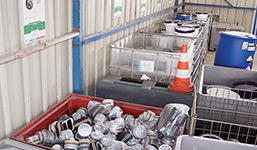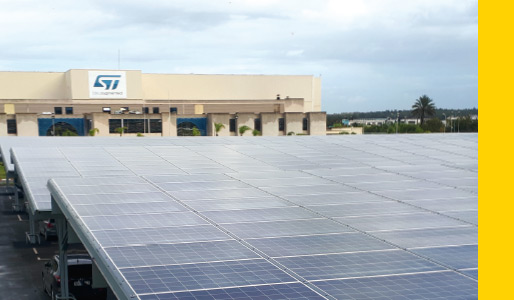Our approach to the environment
2019 was a landmark year for ST. We achieved our goal of reducing our GHG emissions by 21% compared to our 2016 baseline, six years ahead of our 2025 target. In doing so, we confirmed our longstanding commitment to minimizing the impact of our activities on the environment by:
- reducing our environmental footprint, largely by decreasing our direct and indirect emissions (see Energy and Climate Change)
- exploring more renewable energy options (see Energy and Climate Change)
- reducing the use of plastic in our non-manufacturing activities (see Waste and Effluents)
GHG emissions goal achieved
six years ahead of target
Driving environmental efficiency
Good progress on overall environmental performance
In 2019, our ‘eco-footprint score’ was 0.76. This was 0.04 better than our 2018 score and ahead of our 2020 target of 0.80.
Eco-footprint
Our ‘eco-footprint radar’, an internal tool we have been using since 2001, indicates our environmental footprint by gathering data on the inputs and outputs of our manufacturing operations, such as resource consumption, waste and air emissions. The smaller the footprint, the better the performance, with a score of 1.0 or below considered as good. It allows us to compare the environmental impact of each ST manufacturing site, as well as our overall progress year on year. We analyze the results to identify possible improvements and define the priorities we need to address. I 103-3 I
Strong governance
We have managed the environmental impact of our activities for more than 25 years, supported by our Environmental Policy and our Environmental Health and Safety (EHS) Decalogue (both available at www.st.com). Our approach to the environment covers all our major sites, including all manufacturing sites. Dedicated corporate and site teams collaborate to define and implement environmental programs and procedures, review projects, share best practices and evaluate performance. I 103-2 I
Reduced environmental footprint
Environmental risks are reviewed annually through our Enterprise Risk Management and business continuity processes (see Risk Management).
In addition, to prevent any potential negative impacts on the environment, we take a precautionary approach when assessing new processes, chemicals and products, as set out in Principle 15 of the Rio Declaration. I 102-11 I
Enhanced management system
We manage our environmental programs in accordance with international standards such as ISO 14001, ISO 50001 and EMAS. Our environmental performance and management systems are regularly evaluated and certified through internal and third-party audits.
6
EHS legal compliance audits
Moreover, to limit any risks related to our license to operate, we have a three-year program to conduct third-party EHS legal compliance audits. This program covers all our manufacturing sites, all our warehouses and all our sites with more than 150 employees.
In 2019, six EHS legal compliance audits were performed. The Corporate EHS team also carried out internal audits at nine sites (manufacturing sites, R&D centers and sales & marketing offices) to assess the sites’ performance against objectives, programs and procedures.
During 2019, we modernized the data management tool we use to gather and consolidate our environmental data. The aim was to improve the efficiency of the data collection and management process (monthly, quarterly and yearly), and subsequently improve our overall performance. I 103-3 I
Adopting Lean practices

FOCUS
Extending Lean to the environment
Lean practices are part of ST’s day-to-day manufacturing operations as we strive to increase efficiency, reduce waste and enable continuous improvement. In 2019, our Rousset site (France) extended the Lean methodology to its environmental approach to further improve its performance.
Results and feedback are very positive after one year of monthly ‘Gemba walks’, during which the environmental team and on-site contractors visited all environmental areas to observe behaviors and potential deviations. The site noticed a 33% reduction in ‘near misses’ compared to 2018 and an improvement in waste segregation and disposal.
This proactive approach reinforces collaboration between ST teams and the contractors. It also helps raise awareness throughout each organization and promotes good environmental practices.
Working together to tackle environmental challenges
Combining our efforts
A strong and engaged community working on a common action plan to minimize our environmental impact (consumption, recycling), engage external stakeholders and reduce risks (regulations, scarcity, price fluctuation, incidents): this was the main outcome of the international environmental event held in June 2019 at our Muar site (Malaysia).
38
experts, one common action plan
Over three days, 38 environment experts from ST’s major sites around the world worked together to address critical environmental challenges. It was a great opportunity for all to meet, discuss common issues, and share ideas to put in place concrete actions to reach ST’s 2025 goals.
Participants gained valuable insights into 45 best practices covering water consumption and recycling; and waste, energy and emissions management. Suppliers were also invited to discuss environmental challenges and introduce new solutions and innovations.
Participating in industrial and trade associations
In 2019, we continued our work with the European Semiconductor Industry Association (ESIA), the European arm of the World Semiconductor Council, whose aim is to support the long-term, sustainable growth of the semiconductor industry. Our implication was reinforced by the election of Jean-Marc Chery, President and CEO of STMicroelectronics, as the new ESIA President in December 2019.
ST’s experts actively participated and brought their experience, leading several working groups on resource conservation, air emissions, chemicals, and health and safety. Our Corporate Environment Senior Manager, Pascal Roquet, who leads the ESIA EHS committee, worked with peers to define new objectives for 2030.
We are active members of trade associations such as ACSIEL, Alliance Electronique, and Fédération des Industries Electriques, Electroniques et de Communication in France; Federazione Nazionale Imprese Elettrotecniche ed Elettroniche in Italy; and SEMI Europe. We also participate with other semiconductor players in defining the future and considering the environmental impact of the electronics industry. I 102-12 I
Shaping the future
Environmental statement for children

We believe that tackling environmental challenges is a shared concern and working with external stakeholders creates more opportunities for us to shape the future together.
Our Agrate and Castelletto sites (Italy) developed an innovative initiative by creating an environmental statement aimed at children. The 30-page document was based on certified data and distributed to pupils aged between 9 and 10 years old, providing information on ST commitments and achievements in environmental protection. It was supported by a series of lectures from ST employees involving more than 300 students. The initiative received very positive feedback from the children and their teachers, as well as local communities and ST employees.


